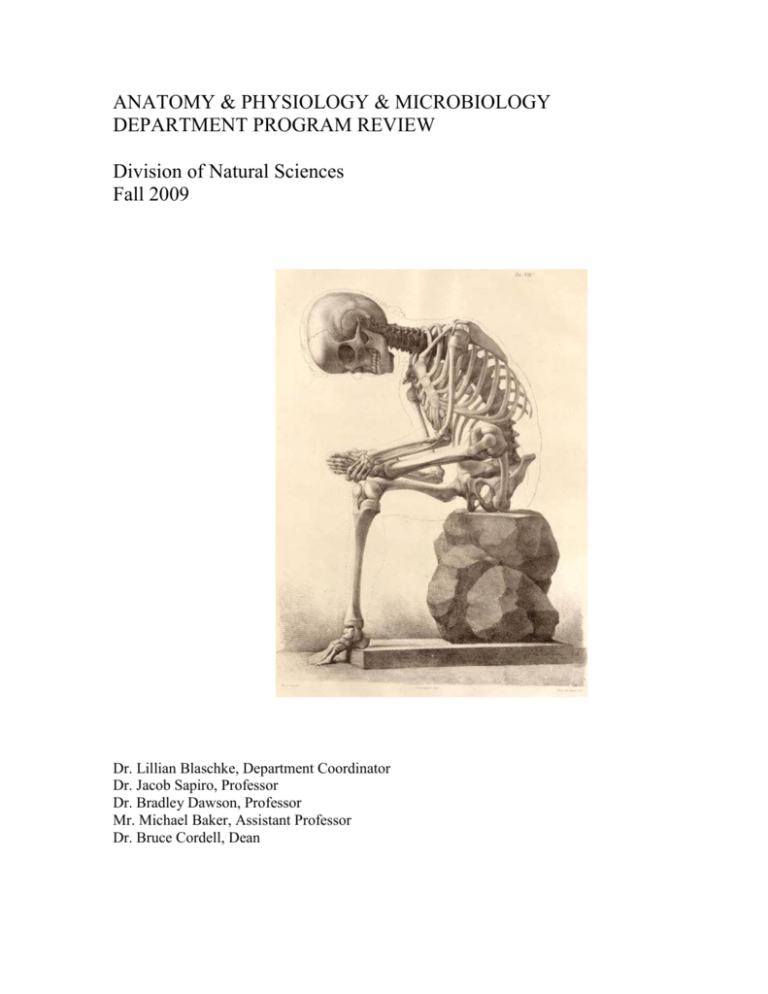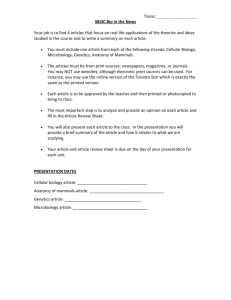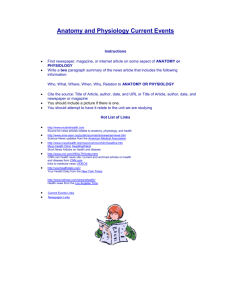ANATOMY & PHYSIOLOGY & MICROBIOLOGY DEPARTMENT
advertisement

ANATOMY & PHYSIOLOGY & MICROBIOLOGY DEPARTMENT PROGRAM REVIEW Division of Natural Sciences Fall 2009 Dr. Lillian Blaschke, Department Coordinator Dr. Jacob Sapiro, Professor Dr. Bradley Dawson, Professor Mr. Michael Baker, Assistant Professor Dr. Bruce Cordell, Dean This program review was prepared by those listed in an open and collaborative process. All full-time faculty in the program have had an opportunity to review the report, and the report was made available to the division as a whole prior to being submitted to PCC. Dr. Lillian Blaschke, Department Coordinator ________________________ Dr. Jacob Sapiro, Professor ________________________ Dr. Bradley Dawson, Professor ________________________ Mr. Michael Baker, Assistant Professor ________________________ Dr. Bruce Cordell, Dean ________________________ December 2009 I. Program Description A. PROGRAM DESCRIPTION AND HISTORY One to two paragraphs regarding the scope and the purpose of the program including a statement regarding evolution of the program over time, acceptable standards for retention, GPA, etc . The departmental offerings are four 200-level lecture-laboratory courses taught exclusively by full-time faculty. These courses comprise the typical entré into the myriad of health profession career pathways that exist. This department truly serves the community in that health profession career goals have for many years been popular. Individuals who successfully attain these goals literally are of the utmost importance to the greater society. The clientele includes mainly undergraduates (of all ages), but there is always a significant number of post-baccalaureate students and others who have changed a career goal or desire to change careers. Our APM courses serve them all. Success rates are high for physiology and microbiology courses and lower for anatomy, the first course in the sequence. This is to be expected because, more so than with other career options, some desire to enter health professions to “give care’ but do not realize the academic intensity of the courses required for all such careers. Of course, there are always individuals who try the entry course a second time and then go on successfully. For those who might be interested in details of the inception and formation of the APM Department, there is a thorough description in the December 1999 Program Review. Since that document was prepared, there have been a number of changes. One faculty member retired. His teaching duties were temporarily absorbed by remaining APM faculty until a new faculty member (Michael Baker) was hired in Fall 2008. Once he was hired, we could again offer 3 sections of Physiology. The prerequisite of a college biological science (with laboratory) for Anatomy was eliminated because it was thought to be unnecessary, and that has proven to be the case. Anatomy and Chemistry were made prerequisites for the Physiology course which has allowed the class to be taught at a higher level and therefore be easier to articulate. Anat 216, Human Anatomy and Physiology was eliminated in Fall 2004 because most colleges were going away from a one semester course in favor of a two semester sequence. To compensate for this, there was an increase in the number of Anatomy sections from 3 to 7 per semester. Microbiology 220 has not been offered since 2004 but remains in the APM course offerings and will be taught again once we move into the new building. B. PROGRAM GOALS Key instructional goals defined in terms of student learning outcomes and workplace outcomes Student Learning Outcomes for individual courses: ANAT 231 F: 1. Outcome: Upon successful completion of ANAT 231 F, the student will be able to compare and contrast normal anatomy to abnormal anatomy associated with various diseases and conditions. Assessment :Objective and essay questions on exams. 2. Outcome: Upon successful completion of ANAT 231 F, the student will be able to identify histological and microanatomical structures. Assessment: Laboratory practica. 3. Outcome: Upon successful completion of ANAT 231 F, the student will be able to interrelate the structure and function of organs and organ systems. Assessment: Objective and essay questions on exams and lab practica. ANAT 240 F: 1. Outcome: Upon successful completion of ANAT 240 F, the student will be able to compile and interpret data acquired in the laboratory. Assessment: Written laboratory reports and essay questions on the exams. 2. Outcome: Upon successful completion of ANAT 240 F, the student will be able to relate how homeostatic mechanisms respond to internal and external changes in the environment. Assessment: Multiple choice and essay questions on the exams. 3. Outcome: Upon successful completion of ANAT 240 F, the student will be able to compare and contrast normal physiological states nonpathological variant states to pathophysiological conditions. Assessment: Written laboratory reports and essay questions on the exams. MICR 220 F: 1. Outcome: Upon successful completion of MICR 220 F, Medical Microbiology, the student will be able to apply basic microbiological principles and laboratory techniques. Assessment: Microbiological principles are assessed primarily with objective and essay exams; laboratory techniques are assessed using written laboratory reports, laboratory practica, and successful identification of unknown microbes. 2. Outcome: Upon successful completion of MICR 220F, Medical Microbiology, the student will be able to outline the disease process and the immune response against infection. Assessment: Written and objective exams 3. Outcome: Upon successful completion of MICR 220 F, Medical Microbiology, the student will be able to identify unknown microorganisms using various differential and selective microbiological techniques. Assessment: Unknown microorganism identification project and report. MICR 262 F: 1. Outcome: Upon successful completion of MICR 262 F the student will be able to apply appropriate laboratory techniques and scientific methodology to determine the identity of an unknown microorganism. Assessment: Unknown organism project in lab. 2. Outcome: Upon successful completion of MICR 262 F the student will be able to identify characteristics of microorganisms that scientists/medical professionals use to prevent and/or eliminate various pathogens. Assessment: How microbiologists and medical professionals take advantage of differences between pathogens and the host cells/tissues is a concept that appears throughout the course; assessment of understanding occurs on multiple exams (both objective and written questions). 3. Outcome: Upon successful completion of MICR 262 F the student will be able to outline potential ways in which microorganisms and humans interact, including the disease process, immunology, medicine, nutrient cycles in the environment, and industrial application. Assessment: Microbe-human interaction is a common theme throughout the course; assessment of understanding occurs on written exams where students are expected to be able to diagram these interactions. Department Student Learning Outcomes: As a result of participation in the program, students will have the following 5-7 skills and : knowledge sets 1.Upon successful completion of the program, the student will be able to understand the language used in health care professions. 2.Upon successful completion of the program, the student will be able to relate normal to pathological states. 3. Upon successful completion of the program, the student will be able to analyze new developments in the health care field. 4. Upon successful completion of the program, the student will be able to utilize their skill sets to assess current events as they relate to health care. 5. Upon successful completion of the program, the student will be able to be facile in a laboratory situation. C. PROGRAM DEGREES AND CERTIFICATES OFFERED The following programs require one or more courses from the APM Department Biology Associates in Art Biological Technician Associates in Science Food and Nutrition Associates in Art Medical Technology Associates in Art Microbiolgy Associates in Art Pre-Nursing Associates in Art Physical Education Associates in Art Physical Education - Fitness Associates in Art Personal Trainer Certificate D. PROGRAM COURSES OFFERED Anatomy and Physiology Courses ANAT 231 F General Human Anatomy (4) Three hours lecture and three hours lab per week. This course includes a logical analysis of body tissues, organs and systems. It stresses the microscopic, developmental and gross anatomy of mammals, with special emphasis on human anatomy. Special attention is given to pathological as well as normal conditions. The lab work includes study of the developmental, microscopic and gross anatomy of preserved specimens and models. This course is designed primarily for physical education and allied health majors, but is also available for interested students of various liberal arts majors who desire or require an understanding of basic anatomy. (CSU) (UC) (Degree Credit) CSU GE, IGETC ANAT 240 F Human Physiology (5) Prerequisite: ANAT 231 F and CHEM 101 F or equivalent, both with a grade of “C” or better Three hours of lecture and six hours of lab per week. This course provides an in-depth study of human function. The focus of the course is maintenance of homeostasis. Organ systems are studied with respect to their interactions under normal and abnormal conditions. Lab experiences reinforce concepts studied in lecture and introduce students to clinical techniques. The course is designed for pre-health profession majors and other students that require a one semester course in physiology. (CSU) (UC) (Degree Credit) CSU GE, IGETC Microbiology Courses MICR 220 F Medical Microbiology (4) Advisory: A lab course in biological science Three hours lecture and three hours lab per week. Includes microorganisms that are significant in the problems of health. Special attention is given to the topics of infectious disease transmission, immunology, prophylaxis, and sanitation. Principles of applied microbiology are stressed. Recommended for students in programs of allied health science. (CSU) (Degree Credit) CSU GE MICR 262 F General Microbiology (5) Prerequisite: A biological science lab course with a grade of “C” or better that includes cellular structure/function and CHEM 101 F or equivalent with a grade of “C” or better Three hours of lecture and six hours of lab per week. This course studies the morphology, taxonomy, metabolism, and molecular genetics of microbes with emphasis on bacteria, protozoa, viruses, helminths and fungi. The role of microorganisms in the disease process, epidemiology, immunology and chemotherapeutic control measures, environment impact and industrial application are discussed. Lab exercises focus on the development of basic techniques in aseptic handling, visualization, and quantification of microbes. Other lab exercises include sampling water and soil for medically or environmentally important microbes, assessing antibiotic sensitivity, fluorescent microscopy, and immuno assays. The course is designed for students pursuing a career or major in microbiology and various allied health professions. (CSU) (UC) (Degree Credit) CSU GE, IGETC E. PROGRAM FACULTY Michael Baker Lillian Blaschke Bradley Dawson Jacob Sapiro Indicate number of adjunct faculty: 0 III. Program Outcomes Analysis A. REPORT ON STATUS OF PREVIOUS REVIEW OUTCOMES ANALYSIS One to two paragraphs regarding accomplishments since the previous review and objectives/activities still outstanding. 1. Completed 6 year program review. 2. Realigned the curriculum to reflect changes at transfer institutions 3. Worked with the PE Department on their Anatomy and Physiology requirement for their programs. 4. Course outlines have been updated 5. Student Learning Outcomes have been written for all of the courses. 6. Department Learning Objectives have been written. 7. Student Learning Outcome Assessment process has been initiated and is expected to be completed by Fall 2010. 8. Course prerequisites have been updated for Anat. 231 and Anat. 240. B. SUMMARY OF DATA – Recommend Evaluation of Data One paragraph each on program access, program resources, program efficiency, and program success. What does the data show? The word “data” is a plural. Please fix the form! 1. Program Access: Students have limited access to the courses within the program because of the limited number of sections offered. We typically enroll over 100% of capacity. Courses like Anatomy and Microbiology are among the first to fill during registration. Currently there is another barrier to access and that is the prerequisite clearance process. For the last three semesters enrollment in Physiology has been adversely affected by the arbitrary and capricious nature of the way students are counseled and treated by A&R. 2. Program Resources: We are currently in temporary quarters and therefore the number of sections we can offer is more limited. We had offered 7 sections of Anatomy in the past and hope to do so again, if not more, when we move into the new building. 3. Program Efficiency: Our program is very efficient, especially considering each of our classes has a laboratory component. We had been at about 600 WSCH/FTEF but this number has decreased because of the slight drop in Physiology enrollment (see section 1 above.) Even so, our efficiency is still high at about 550 WSCH/FTEF. At this rate we are still making a profit for the College. The year by year numbers do not seem to reflect the actual enrollment rates and we question their validity. 4. Program Success: Our success rates are very high considering the rigor of these courses. Obviously Anat. 231, the introductory course has the lowest success rate at about 45%. This is in line with other introductory major’s courses at the College. The success rates for the subsequent courses in the Department are considerably higher with Microbiolgy at over 70%. The real measure of success is transfer, and we do not have any data for this, although our anecdotal evidence is that all students who successfully complete our program go on to transfer institutions. C. IDENTIFICATION OF TRENDS Two to three paragraphs on factors influencing the program: workplace trends, changes in curriculum/content, changes in pedagogy, other factors. 1. Workplace trends: The health care professions are still the fastest growing fields of employment and there seems to be no end in sight. 2. Changes in curriculum and content: Courses are constantly being revised as changes in science and technology occur. Laboratory activities and lectures are modified to keep them current in the field. 3. Changes in pedagogy: Computerized laboratory activities have been included into the Physiology course. New materials have been acquired for the Anatomy course. D. IMMEDIATE SHORT-TERM PLANS Drawing from the data, external influences, trends in the discipline and College goals/initiatives, identify concrete activities the program needs to engage in to modify the program. Can activities be accomplished in 1-2 years? The main current issue is our lack of facilities. We hope this situation will be rectified when we move into the new building and have a laboratory room dedicated to Anatomy, a separate laboratory room to be used by Microbiology and another laboratory room for Physiology. E. LONG-TERM PLANS Drawing from data, external influences, trends in the discipline, and college goals/initiatives, identify concrete activities the program needs to engage in to modify the program. Can activities be accomplished in 3-5 years? Once we move into the new building and have the appropriate facilities, we would like the Department to grow. The student demand suggests that we should add at least 2 sections of Microbiology each year and at least 2 sections of Anatomy each year. This would ultimately necessitate the hiring of an additional full-time faculty member. F. REQUEST FOR RESOURCES Identify specific resources needed for specific activities (and potential sources for support). The APM program is a very intensive in its use of equipment and supplies. The only way we can grow the program is to have additional allocation of money for supplies and equipment. Also more money needs to be put into the program to keep it current. For example, right now, we only have 3 computer stations for the Physiology class. This needs to be increased to at least 6 - one per laboratory table.







